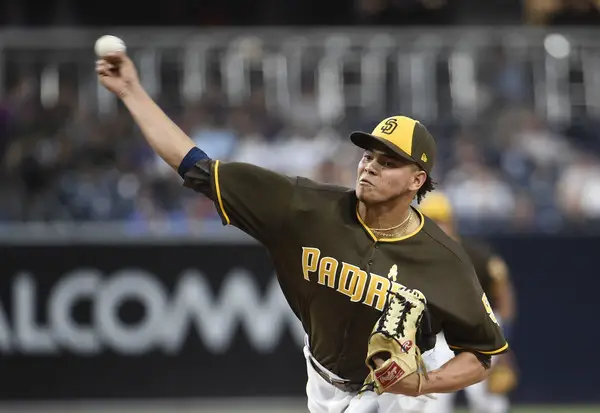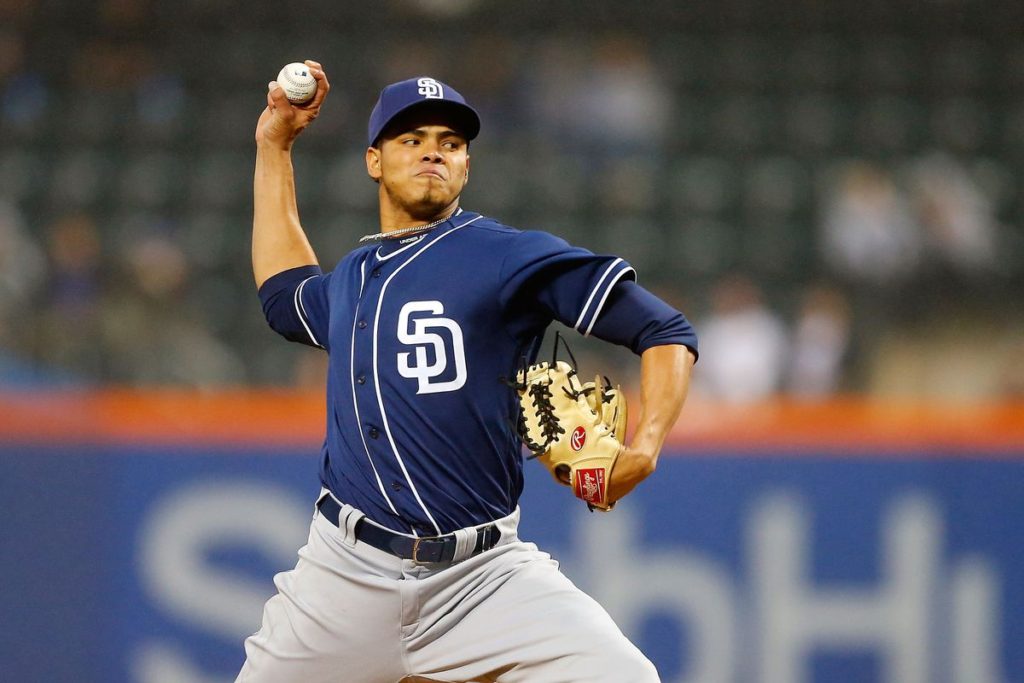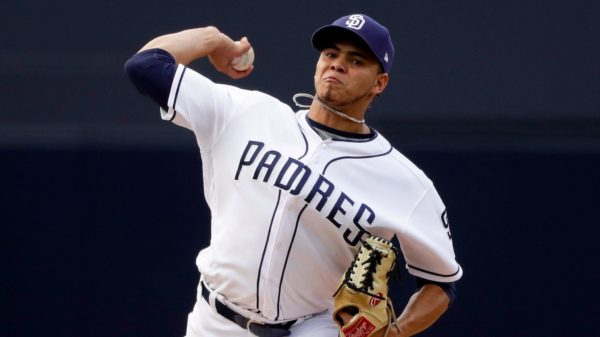The Padres’ Forgotten Man: Dinelson Lamet

Credit: Getty Images

Can San Diego Padres’ right-handed pitcher Dinelson Lamet contribute in 2019 as he recovers from arm surgery?
Due to the fact he missed the entire 2018 season, and what looks like the beginning of 2019 as well, Dinelson Lamet has become the best player on the Padres roster that nobody is talking about.
After an intriguing introduction to the majors during the 2017 season, in which opposing batters hit .207 against him and he posted K/9 of 10.94, Lamet suffered an injury towards the end of spring training and underwent Tommy John surgery in 2018.
The 2017 season for Lamet did come with its struggles. One of his main issues was the development of his changeup. His changeup significantly lagged behind his other two pitches and was nothing more than in its nascent stages. Despite having plus velocity, Lamet and the Padres’ pitching staff knew he would need to add a third pitch in order to have future success at the big league level.
Lamet also struggled when it came to locating his pitches at times. He would go on to average 4.25 BB/9, and also gave up 1.42 home runs per nine innings. These statistics were early indications that Lamet did not consistently locate his pitches well and that there was still much-needed development when it came to the young right-hander. One could describe Lamet as more of a thrower than a pitcher right now, but the foundation for success is there with two plus-pitches and premium athleticism that allows him to consistently repeat his delivery.
As mentioned earlier, Dinelson Lamet does have above-average velocity. His fastball typically sits in the 95-98 mph range and it jumps on hitters quickly. Being able to locate his fastball with the proper command will give him the ability to enhance his secondary pitches, by either landing them in the zone or utilizing them as a chase pitch.
The right-hander’s slider is another plus pitch and his go-to strikeout pitch. He throws it from 85-87 mph consistently and has the ability to throw it for a strike or bury it as a chase pitch out of the strike zone. During the 2017 season, his slider created many uncomfortable swings from opposing hitters who seemed to not pick it up well out of his hand.
Both his fastball and slider are above-average major league pitches, but when you are going through a major league lineup a second or third time, even the best fastball and slider can be barreled up when professional hitters can anticipate it.

During the 2017 season, Lamet began working on a changeup to give him a third pitch to keep hitters off balance. By the end of the season, he was starting to appear to have more confidence in the pitch and more willing to throw it during key moments in a game. In the spring of 2018, prior to his injury, he was showcasing a 5-to-11 curveball with good bend and sharp bite.
At the end of the day, Lamet needs a third pitch to keep hitters honest and off balance. The decision on whether that ends up being a curveball or a changeup will ultimately be up to him and the Padres’ coaching staff. His continued development of these additional pitches to his repertoire will be the difference between Lamet becoming a starter or a reliever moving into the future.
Due to this combination of current pitches, the potential he possesses is varied greatly. If it all comes together, with three to four average to above-average pitches, Lamet fits nicely towards the front of the rotation. If he ultimately fails to develop his curveball or changeup, he easily possesses the competitiveness and stuff to fit into the back end of the bullpen, throwing high leverage innings.
The Padres will give him every opportunity to stay in the rotation and try to maximize his potential. The team hopes to see him rejoining the active major league roster sometime around the All-Star break in 2019.
With Lamet joining the roster around the midpoint, it affords the team some flexibility as to how they deploy him in the short-term for 2019. He could rejoin the roster as a starting pitcher, but a common strategy to assimilate pitchers coming back mid-season from Tommy John is by sticking them in the bullpen to ease him back into a major league workload. Regardless of what role Dinelson Lamet has in 2019, it will be exciting to see what he does on the mound at Petco once again.
I am a lifelong Padres Fanatic who loves to talk and debate any and all sports. But SD Padres and minor leagues hold a special place above all. A 33-year-old born and raised San Diegan who is a season ticket holder and puts his money where his mouth is.
Can you provide an update on his rehabilitation
I agree with Lorenzo that this was a very good and incisive writeup on Lamet. There are several young Padre pitchers that bear watching as they come back from injury and develop – Gore with his blisters; Baez with his stiff back; Morejon with his “minor” arm injuries, among the most prominent – but the two I have most interest in are Lamet and Anderson Espinoza. We can only hope that both bounce back with the same degree of success as Paddack did this year. I hope to see both at Lake Elsinore sometime in 2019 and possibly Lamet in San Diego at the tail end of the year if all goes well.
Good writeup. Lamet is probably forgotten by all but the most rabid fans, but not by Preller’s brain trust. The TJ surgery was a bad break in his development, but if Preller’s people are smart (and they are), they’ll see it as an opportunity to fix Lamet’s flaws, primarily his inconsistency. His delivery will have to be rebuilt after such a long layoff, and that’s a chance to get him into the rhythm of a repeatable delivery, what Darren Balsley preaches..
There are no guarantees with TJ, but if his velocity and slider come back, I’d expect him to spend time in the minors first, before bringing him up. After TJ, MLB gives a team the option of an extended rehab period in the minors, and I’d expect the Padres to make full use of it. He may not get a callup until September, with all the starters due to make their appearances in the latter part of the season.